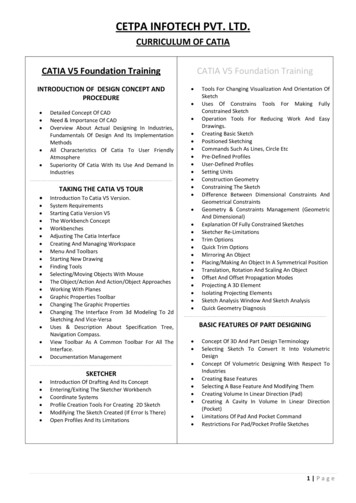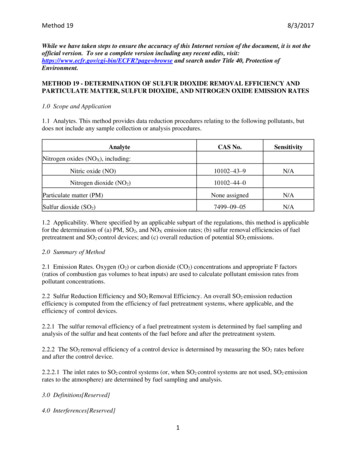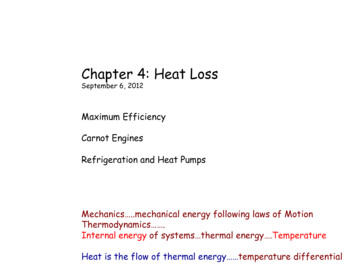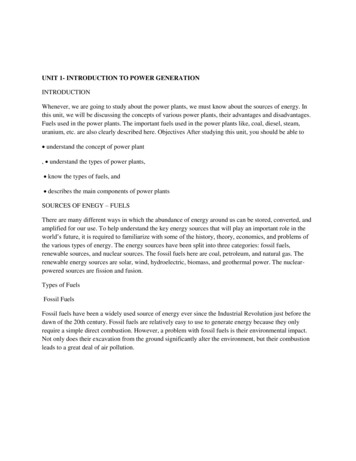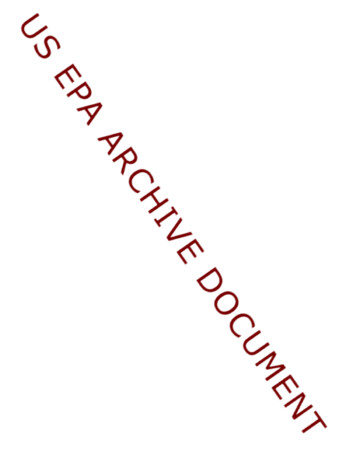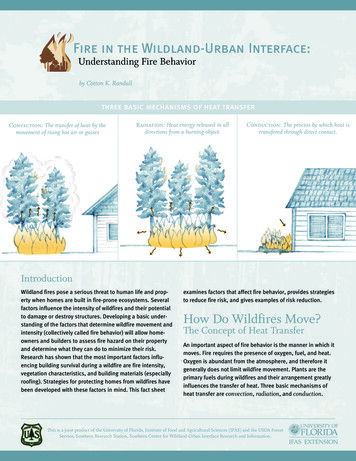
Transcription
This file was created by scanning the printed publication.Errors identified by the software have been corrected;however, some errors may remain.United StatesDepartment ofAgricultureForest ServiceIntermountainForest and RangeEvperiment StationOgden, UT 84401General TechnicalReport INT-129August 1982Handbook forInventorying SurfaceFuels and Biomass inthe Interior WestJames K. r o w nRick,D. Oberheu,and Cameron M. Johnston
THE AUTHORSCONTENTSJAMES K. BROWN received his bachelor's degree fromthe University of Minnesota in 1960, his master's fromYale University in 1961, and his Ph.D. from the Universityof Michigan in 1968, all in forestry. From 1961 to 1965, hedid research on field measurement of fuel properties andfire-danger rating systems while with the Lake StatesForest Experiment Station. In 1965, he transferred to theNorthern Forest Fire Laboratory, Missoula, Mont., wherehe conducted research on the physical properties, inventory, and prediction of fuels. He currently is leader of afire effects and use project in Missoula.PageINTRODUCTION . . . . . . . . . . . . . . . . . . . . . . . . . . . . . . . . . 1CHOICE OF TECHNIQUES. . . . . . . . . . . . . . . . . . . . . . . . . 2StandingTrees . . . . . . . . . . . . . . . . . . . . . . . . . . . . . . . . 2Shrubs . . . . . . . . . . . . . . . . . . . . . . . . . . . . . . . . . . . . . . . 2Herbaceous Vegetation . . . . . . . . . . . . . . . . . . . . . . . . . 3Litter and Duff . . . . . . . . . . . . . . . . . . . . . . . . . . . . . . . . . 3Downed Woody Material. . . . . . . . . . . . . . . . . . . . . . . . . 4PROCEDURES . . . . . . . . . . . . . . . . . . . . . . . . . . . . . . . . . . 4Number of Sample Points. . . . . . . . . . . . . . . . . . . . . . . . 5Fieldwork. . . . . . . . . . . . . . . . . . . . . . . . . . . . . . . . . . . . 5Field Equipment . . . . . . . . . . . . . . . . . . . . . . . . . . . . . . . 1 3Calculations . . . . . . . . . . . . . . . . . . . . . . . . . . . . . . . . . . 14PUBLICATIONS CITED . . . . . . . . . . . . . . . . . . . . . . . . . . . .19APPENDIX IApplicability of Techniques . . . . . . . . . . . . . . . . . . . . . . 21APPENDIX IISampling Procedures . . . . . . . . . . . . . . . . . . . . . . . . . . . 21APPENDIX IllComputer Instructions . . . . . . . . . . . . . . . . . . . . . . . . . . 2 2APPENDIX IVFieldwork Hints. . . . . . . . . . . . . . . . . . . . . . . . . . . . . . . . 4 8RICK D. OBERHEU received his bachelor's degree inforestry from the University of Montana in 1973. In 1974,he joined the Northern Forest Fire Laboratory, where heworked extensively with fuel and vegetation inventory ona fire effects and use project. He currently is a fuelsmanagement specialist on the Wallowa-Whitman NationalForest.CAMERON M. JOHNSTON attended the University ofMontana from 1965 to 1969. He worked as an engineeringdata processor for the USDA Forest Service NorthernRegion from 1969 to 1972. In 1972, he became the computer programmer for the fuel science research work unitat the Northern Forest Fire Laboratory. In 1978, hebecame the computer specialist for the Division of Aviation and Fire Management for the Northern Region. Hecurrently is a programer analyst with the Fire Effectsand Use R and D Program at the Northern Forest FireLaboratory.IThe use of trade, firm or corporation names in this publication is for theinformation and convenience of the reader. Such use does not constitute anofficial endorsement or approval by the U.S. Department of Agriculture ofany product or service to the exclusion of others which may be suitable.RESEARCH SUMMARYComprehensive procedures for inventorying weight perunit area of living and dead surface vegetation are presented to facilitate estimation of biomass and appraisalof fuels. The authors show how to conduct fieldwork andestimate weight per unit area of downed woody material,forest floor litter and duff, herbaceous vegetation, shrubs,and small conifers. Weights by species are determined forshrubs and small conifers. Coverage of shrubs andherbaceous vegetation are estimated. The several sampling methods involve the counting and measuring diameters of downed woody pieces that intersect verticalsampling planes, comparing quantities of litter and herbaceous vegetation against standard plots that areclipped and weighed, tallying shrub stems by basaldiameter classes, tallying conifers by height classes, andmeasuring duff depth. The procedures apply mostaccurately in the Interior West; however, techniques forherbaceous vegetation, litter, and downed woody materialapply anywhere. A computer program and card punchinginstructions are included for processing inventory data.Approved for publication by Intermountain StationFebruary 1981I
Un tedStatesDepartment ofAgricultureForest ServiceIntermountainForest and RangeExperiment StationOgden, UT 84401General TechnicalReport INT-129August 1982Handbook forInventorying SurfaceFuels and Biomass inthe Interior WestJames K m Brown, Rick Dm Oberheu,and Cameron M. JohnstonINTRODUCTIONThis publication describes procedures for inventoryingweight of forest floor duff, forest floor litter, herbaceousvegetation, shrubs, small conifers, and downed woodymaterial (fig. 1). The procedures furnish estimates for liveand dead vegetation by diameter classes. The inventorymethods have application to several facets of forest andrange management and to research investigations.The procedures were initially developed to provide estimates of fuel loading (weight per unit area) as part of aneffort to appraise fire behavior potential for planning firestrategies in wilderness areas (Habeck and Mutch 1973;Aldrich and Mutch 1972). Although the methodologyemphasizes forest fuels, estimates of abovegroundbiomass of herbaceous vegetation, shrubs, and smallconifers may be useful for purposes other than fuelFigure 1.-Vegetative components included in procedures for estimating biomass andfuel loading.
appraisal. The procedures were used by numerous fieldcrews for several years. This experience aidedconsiderably in developing the step-by-step proceduresreported here.The inventory procedures are useful for determiningbiomass of any vegetation up to about 10 ft (3 m) inheight. The entire set of procedures or a part of them canbe applied to estimate all or any one of the vegetativecomponents.The procedures apply most accurately in the InteriorWest. The techniques for estimating biomass of herbaceous vegetation, litter, and downed woody material, however, apply anywhere. The shrub techniques apply mostaccurately to shrubs in the Northern Rocky Mountains.Considering sampling efficiency as attainment of desiredprecision by the most practical means, the most efficientmethods of sampling vegetation vary by plant species andpurpose. Different techniques are required to most eificiently sample all vegetation. Thus, the single set of procedures assembled here may not be the most efficient forsome situations. Nevertheless, the procedures are appropriate for sampling each category of vegetation and canbe widely applied with a minimum of training and experience. Further discussion on applicability of techniques isin appendix I.The inventory procedures specify sampling of branchand stemwood under 3 inches in diameter by diameterclasses of 0 to 0.25 inches (0 to 0.6 cm), 0.26 to 1.0 inches(0.6 to 2.5 cm), and 1.0 to 3.0 inches (2.5 to 7.6 cm). Thesize classes correspond in increasing size to I-,lo-, and100-hour average moisture timelag classes for manywoody materials (Fosberg 1970). The size classes areused as moisture timelag standards in the U.S. NationalFire-Danger Rating System (Deeming and others 1977;. Amoisture timelag is the amount of time for a substance tolose or gain approximately two-thirds of the moistureabove or below its equilibrium moisture content. Appraisalof forest fuels is greatly facilitated when data on biomassare assimilated by these size classes.Fuel depth was originally included in the proceduresbut was removed because interpretation of fuel depth wascomplex and required trained people to evaluate thereasonableness of depth observations. Although Albini(1975) developed an algorithm that was largely successfulin processing fuel depth data for input to Rothermel's(1972) fire spread model, spurious depth measurementscoupled with the fact that fire behavior predictions werehighly sensitive to depth, continued to cause erraticpredictions. In predicting fire behavior using Rothermel'smodel, depth together with loading is required to determine fuel bulk density. Recent research (Brown 1981)indicates that characterization of bulk density for understory vegetation and fuel groups may eliminate the needfor measurement of fuel depth in inventorying fuel forpractical applications.To assure reasonable fire behavior predictions, inventoried fuel loadings should be interpreted by fire behaviormodeling specialists for proper input to Rothermel'smodel. Estimates of certain fuel components such asdowned woody material and duff can be used withoutinterpretation in operating Albini's (1976) burnout model.This model is incorporated in a computer program calledHAZARD, which appraises slash fuels (Puckett and others1979). As the technology in fire behavior modeling grows,other direct applications of fuel inventory may arise.CHOICE OF TECHNIQUESAn efficient inventory of all fuel and understoryvegetation requires several techniques because of thevaried physical attributes of vegetation. Forest vegetationis comprised of living and dead plants, both standing anddowned. Plants range in size from small grasses andforbs to large shrubs and trees. Pieces of vegetation considered as fuel particles range in size from small leaves,needles, and twigs to large branches and tree boles.Vegetation and fuels having similar physical characteristics, which can be appropriately sampled using thesame technique, can be grouped as follows:1. Standing trees2. Shrubs3. Herbaceous vegetation (grasses and forbs)4. Forest floor litter (01 horizon)5. Forest floor duff (02 horizon)6. Downed woody material.The inventory procedures assembled here are made upof different techniques for each category of vegetation.Before presenting the procedures, methods of samplingand reasons why certain techniques were chosen are discussed for each category of vegetation.Standing TreesA method for estimating biomass of conifers less than10 ft (3 m) in height was included in the procedures presented here because small trees can contribute significantly to propagation of both surface and crown fires. Themethod requires measurement of number of trees peracre by species and height. Biomass of foliage andbranchwood by size class is calculated from weight andheight relationships developed by Brown (1978).Biomass of trees over 2 inches (5 cm) d.b.h. can be estimated from biomass tables or from tree volume estimatesconverted to weight using wood densities (USDA 1974). Todetermine volumes from tree volume tables, estimates ofthe number of trees per acre or basal area per acre byd.b.h. and species required to access the tables can bedetermined from commonly used plot and plotless sampling met hods. Procedures for inventorying trees greaterthan 10 ft (3 m) in height are not included here becausethey are commonly understood and used in forestry. Ifdesired, they can be readily applied along with the procedures for surface vegetation.ShrubsShrub biomass can be estimated nondestructively byone of two basic methods. One approach relates biomassto stem diameters as described by Telfer (1969) for shrubsin eastern Canada, and Brown (1976) for shrubs in theNorthern Rocky Mountains. High correlations betweenstem diameters and weights of various shrub parts havebeen reported (Lyon 1970; Buckman 1966; Whittaker 1965).This approach requires a tally of number of stems bystem diameter on plots of known size. Another methodrelies on the relationships between biomass, canopy area,
and canopy volume as described for semidesert shrubs inNew Mexico (Ludwig and others 1975), sagebrush(Artemisia tridentata) (Rittenhouse and Sneva 1977), andlow shrubs in California (Bently and others 1970). Thismethod requires measurements of crown diameters andshrub height.The method involving measurement of stem diametershas the advantage of applying easily to tall shrubscompared to the method of measuring crown dimensions.Measurement of stem diameters probably permits themost accurate estimation of biomass because stemdiameters should relate more directly to biomass thandoes space occupied by shrubs. A disadvantage ofmeasuring stem diameters is that fieldwork can involveconsiderable time, especially for small shrubs comprisedof many stems such as grouse whortleberry (Vacciniumscoparium). The fieldwork can be minimized by recordingdiameters by size classes. The method requiring measurement of crown dimensions is rapid and well suited tosmall- and medium-size shrubs. The method involvingmeasurement of stem diameters was incorporated inthese procedures because it applies to shrubs of all sizes,and relationships for estimating biomass of leaves andstemwood by diameter class were available for 25 species(Brown 1976).Herbaceous VegetationAn extensive body of literature exists on estimatingweight and production of range vegetation. Techniquesfor estimating weight basically fall into three categories:(1) clipping and weighing, (2) estimation, and (3) acombination of weighing and estimation.To aid in extensive surveys, a quick, easy-to-usemethod is needed for estimating weight. Studies inpasture grasses (Pasto and others 1957) and annual rangespecies (Reppert and others 1962) gave reasonably highcorrelations between weight per unit area, and groundcover and height. Similar investigation of grasses, forbs,and small woody plants in forest areas showed that asmore plant sizes and shapes are included in plots, pooreraccuracy can be expected (Brown and Marsden 1976).Unless relationships of suitable accuracy are known forspecific sites, some clipping and weighing is desirable forestimating herbaceous vegetation.The weight-estimate method has been widely used andtested in the southern and western United States in avariety of vegetation including large and small grassesand understory vegetation. It requires an estimate ofactual weights and can be effectively used with doublesampling on clipped and weighed plots. Trained observerscan estimate within 10 percent of actual weights (Hughes1959). When used with double sampling, variance of estimates can be reduced (Francis and others 1979). Thismethod, coupled with double sampling, has proved veryuseful in estimating forest floor litter and herbaceousfuels for research purposes.Another similar technique, the relative-weight estimatemethod (Hutchins and Schmautz 1969) has been useful inestimating fuels. This method is based on the assumptionthat it is easier to compare weights than estimateweights. It involves identifying a base plot having themost weight from a set of four or five plots. The weighton the other plots is estimated as a fraction of the baseplot. The base plot is then clipped and weighted andweights on other plots calculated as a fraction of thebase plot.The relative weight-estimate method was incorporatedin these procedues because it is easy to use, requires aminimum of training, and is based on some clipping andweighing. The advantages and disadvantages of thismethod include:Advantages1. Requires little training or experience to learn themethod; remembering weight images is minimal.2. Checking weight estimates against actual weights isunnecessary.3. Estimates are not affected by changes in light andmoisture content as can happen with the weight-estimatetechnique.4. Quantities of vegetation can be rated on a relativebasis more easily than they can be actually estimated.Disadvantages1. The set of plots must all be readily visible to theobserver to permit accurate comparisons.2. Clipping and bagging on one out of every four or fiveplots is necessary.3. Accuracy of the method has had little study.4. Probably not as accurate as weight-estimate methodused by trained and experienced observers.Litter and DuffSampling the forest floor litter separately from the duffis desirable because the litter is usually much less densethan the duff and frequently burns independently of theduff. The most accurate method of estimating forest floorweights is by collecting and weighing samples. Thisnecessitates a cumbersome field procedure involvingtransport of soil containers and eventual ovendrying.Attempts to correlate stand characteristics and forestfloor weights and depths have not always been successful. For example, forest floor weights in red pineplantations (Dieterich 1963) and ponderosa pine stands(Ffolliott and others 1968) were highly correlated with treebasal area. On the other hand, relationships betweenforest floor weights and basal area, site index, and standage were insignificant in natural stands of red pine andjack pine (Brown 1966), and poorly correlated in easternwhite pine (Mader and Lull 1968). In an extensive study ofsouthwestern ponderosa pine and mixed conifers, Sackett(1979) found a lack of reliable relationships for predictingforest floor quantities from basal area or duff depth.Factors such as fire history, decay rates, and storms canstrongly influence forest floor quantities. Thus, highcorrelations between forest floor quantities and basalarea, site index, and stand age appear to have a limitedbasis-low correlations should not be surprisi,ng. Therelationship between depth and weight of duff can beused to estimate weight recognizing that accuracy can below. Measurement of duff depth was adopted for theseprocedures because:1. Collecting and weighting duff would be impracticalfor large inventories.2. The literature on duff bulk density seemed substantial enough to use in estimating weight from depth.
3. Depth is easily measured and can be a useful measurement itself for planning and evaluating prescribedfires conducted for fuel reduction and site preparation.The bulk densities in table 1 served as a basis forestablishing the following bulk densities that are used inthe computer program to calculate duff loadings fromduff depth:Cover typeBulk densityLblf t3581. Ponderosa pine2. Lodgepole pineDouglas-firShrubfieldsGrand fir3. OthersPROCEDURES10Because the bulk densities used to calculate duffweights are approximations, the weights are approximations and must be interpreted accordingly. If desired,bulk densities other than those above can be used tocalculate duff loadings as described in the section oncalculations.Litter depth was not adopted as a basis for estimatinglitter weight because the literature on bulk density of litterwas scant. More important, perhaps, is that considerablejudgment is required to identify the top of litter. Thisproblem is serious because the litter layer is often verythin and large errors in depth measurement could result.The relative weight-estimate technique was chosen forlitter because it applies readily to litter and was alsobeing used for herbaceous vegetation.Downed Woody MaterialDowned woody material is the dead twigs, branches,stems, and boles of trees and shrubs that have fallen andlie on or above the ground. Loadings of downed woodymaterial vary considerably among stands due primarily tosite productivity and stand history (Brown and See 1981).Table 1.-BulkCollecting and weighing downed woody material isimpractical in most forest stands. The planar intersecttechnique (Brown 19746; Brown and Roussopoulos 1974)adopted here is nondestructive and avoids the time-consuming and costly task of collecting and weighing largequantities of downed woody material. It has the sametheoretical basis as the line intersect technique (VanWagner 1968). The planar intersect technique involvescounting intersections of woody pieces with verticalsampling planes that resemble guillotines droppedthrough the downed debris. Volume is estimated; thenweight is calculated from volume by applying estimatesof specific gravity of woody material.The procedures in this section are an assembly ofsampling techniques that provide estimates of thefollowing variables:1. Biomass and fuel loading on an ovendry basis of:a. Downed woody materialb. Forest floor litter and duffc. Herbaceous vegetationd. Shrubse. Conifers less than 10 ft (2 m) in height.2. Depth of duff and height of shrubs and small trees.3. Percentage cover of herbaceous vegetation andshrubs.4. Percentage of dead in herbaceous vegetation andshrubs.5. Percentage cover of forest floor litter.6. Number of small trees per acre by species.7. Stand age.In addition, provision is made for recording and summarizing slope, elevation, aspect, cover type, and habitatty PeThe field procedures involve counting shrub and smalltree stems and intersected pieces of downed woodydensities of forest floor duff summarized from literatureForest typePonderosa pineForestfloor layerLocationMont.Ariz.Ponderosa pineWash.Mixed conifersWash.Eastern white pineMass.Bulk densityMeanStandarddeviationF, H2.10FHBasalt (F,H)other soil (F,H)Basalt (F,H)other soil (F,H)0.15.44SourceBrown (1970)Ffolliott and others (1968)Wooldridge (1968)Wooldridge (1968)FMader and Lull (1968)HLodgepole pineFir hemlockFir hemlockWhite spruce, balsam, poplarWhite pineWhite pinelhemlockRed pineJack pine-Wyo.Wash.Wash.OntarioWisc.N.Y.Minn.Mich.F. HMull (F,H)Mull (F,H)Mull (F,H)Mull (F,H)Greasy Mor (F,H)F, HF.H1.9Brown (1974a)Williams and Dyrness (1967)Mader (1953)Mader (1953)Mader (1953)Mader (1953)Brown (1966)Brown (1966)
material; measuring diameters, depth, and height of vegetation; ocularly estimating percentage of cover andpercentage of dead vegetation; and extracting incrementcores for determining tree age. All the procedures may befollowed to furnish estimates of all vegetation, or asubset of the procedures may be used to furnish an estimate of any single variable such as duff depth or shrubbiomass. For an average amount of vegetation, about 15minutes per sample point are required to completemeasurements. Counting shrubs and clipping herbaceousvegetation and litter require the most time.Deciding when to sample.-The time of year whenvegetation, especially grasses and forbs, is sampled hasa large influence on results. Grasses and forbs may notbe fully developed during late spring or early summer.Sampling at that time will result in low estimates. Duringlate summer, some annuals may have cured and deteriorated to such an extent that their biomass cannot Beaccurately estimated. The time of year when sampling isdone must agree with the purpose of inventory. Forappraising fuels, sampling during the normal fire season,such as late July and August in the western UnitedStates, is recommended.Number of Sample PointsFor any area where estimates are desired, at least 15 to20 sample points should be located. This sampling "intensity will often yield estimates having standard errorswithin 20 percent of the mean estimates (appendix 11).Areas larger than approximately 50 acres containing ahigh diveraity in amount and distribution of fuel andvegetation, should be sampled with more than 20 pointsto achieve standard errors within 20 percent of meanestimates.Changing the size of plots also influences the desirednumber of sample points. For sampling downed woodymaterial, these procedures accommodate a variablelength sampling plane. Choose sampling plane lengthsfrom the following tabulation:Downed materialNonslash (naturallyfallen material)Discontinuouslight slashContinuous heavyslashDiameter of debris0-1 inch1-3 inches 3 inches- - - - - Sampling plane (ft) - - - - 610-1235-50610-1235-503615-25If material larger than 3 inches (7.6 cm) in diameter isscanty or unevenly distributed, the longer sampling planesin the tabulation should be used.For fuel and vegetation other than downed woodymaterial, plot sizes could be changed. If the computerprogram listed in appendix Ill is used to calculate loadings, however, it would have to be modified or its outputcorrected to adjust for different plot sizes. Variablesampling plane lengths are accounted for, in the program.The amount and distribution of vegetation, especiallydowned woody material, varies greatly among and withinstands. Thus, these sampling recommendations should beconsidered approximate because a greater or fewernumber of sample points may be required to furnishadequate precision for any given area. Sampling intensities are discussed further in appendix 11.FieldworkLocating Sample PointsAfter determining sampling area, such as a stand,delineate or describe its boundaries. Definition of the areaand its boundaries should satisfy a sampling designbased on a clear objective for the sampling. Samplepoints may be systematically or randomly located; however, systematic placement is usually the most practical.Two methods are:1. Locate plots at a fixed interval along transects thatlace regularly across a sample area (uniform samplinggrid). For example, on a sample area, mark off paralleltransects that are 5 to 10 chains (100 to 200 m) apart.Then, along the transects, locate plots at 1- to 5-chain(20- to 100-m) intervals.2. Locate plots at a fixed interval along a transect thatruns diagonally through the sample area. To minimizebias, have the transect cross areas where changes infuels or biomass are suspected. Before entering thesample area, determine a transect azimuth and distancebetween plots. Distance between plots can be paced byfoot or sampling rod. If variations in biomass across anarea are obvious and significant, it may be desirable todivide the area into recognizable strata and sample eachstratum separately.Hints for conducting fieldwork are listed in appendix IV.Plot LayoutThe plot layout at a sample point consists of arandomly positioned line transect for downed woodymaterial and duff, a 11300-acre plot for trees, twoIh-milacre plots for shrubs, and four 0.98 by 1.97-ft (30 by60-cm) plots for herbaceous material and litter (fig. 2).Downed woody material, litter, herbaceous vegetation,shrubs, and small trees are measured on plots laid outparallel to the slope. Thus, calculations of loading on ahorizontal acre basis require slope correction. Duff depthis measured vertically so that slope adjustment is unnecessary for calculating loading.Step I: Mark the sampling point Nith a chaining pin (No.9 wire or similar item). Avoid disturbing materialaround the point so that measurements can beaccurately made.Step 2: Randomly determine direction of the samplingplane in one of two ways:(1) Toss a die to indicate one of six 30" anglesbetween 0 " and 150". The 0 " heading is thedirection of travel. Turn a fixed direction, such asclockwise, to position the sampling plane.(2) Orient the sampling plane in the directionindicated by the second hand of a watch at agiven instant. To avoid bias in placement of thesampling plane, do not look at the fuel or groundwhile turning the interval.Step 3: Denote position of sampling plane by placing a6.8-ft inventory rod (diameter of 11300-acre plot)out from the chaining pin parallel to the groundin the direction determined in step 2 (fig. 2). A
50-foot tape is used along this same line to measure large pieces. The tape and rod fix the position of vertical sampling planes.Step 4: Next, locate four relative estimate subplots andtwo %-milacre shrub plots on the ground asshown in figure 2. Mark the two shrub plots withchaining pins or similar devices. They are located90"to the sampling plane. Place the relativeestimate frames parallel to the slope, and maintain this position when collecting samples (fig. 3).Similarly, count shrub stems from plotsdelineated parallel to the slope.Vegetation to be sampled by each technique issummarized in table 2. Some vegetation could be sampledby more than one technique. To avoid double sampling ofany component, definitions of vegetation to be sampledby each technique must be consistently and closelyfollowed.Small TreesFigure 2.-Plotlayout at a sample point.Table 2.-VegetationVegetationcategoryFigure 3.-Positioning sample frames forthe relative estimate technique on the surface of the forest floor.to be sampled by different biomass techniquesTechniqueSampled vegetationDownedwoodymaterialPlanarIntersectTwigs, branches, stems, and tree boles in and above the litterLitterRelativeweightLitter is the 01 horizon or "L" layer of the floor and includes freshly fallen leaves, needles, barkflakes, cone scales, fruits, dead matted grass, and a variety of miscellaneous vegetative parts.Include cones that are more than one-half in or above the litter. If they are more than one-half belowthe litter, treat as duff. Omit sampling downed woody material as part of the litter because it issampled by the planar intersect method.DuffDepthmeasurementDuff is the 02 horizon or fermentation ahd humus layers of the forest floor. It lies below the litter andabove mineral soilHerbaceousplantsRelativeweightestimateAll live and dead grasses, sedges, and forbs. Dead grasses and forbs detached and fallen from theirgrowing point should be considered litter. Some small woody plants such as bunchberry (Cornuscanadensis), twinflower (Linnea borealis), prince's pine (Chimaphila umbellata), and kinnikinnick(Arctostaphylos uva-ursi), should be sampled as herbs because the shrub method is inapplicable. Ifdesired, small woody plants can be sampled separately using an extra form.ShrubsStem countsAll woody shrubs except those included in the herbaceous sample. Include common juniper(Juniperus communis) as a shrub.SmallconifersTree countsAll conifers except common juniper. Small deciduous trees such as aspen, cottonwood, and birchcan be handled as tall shrubs.
MeasurementsAfter the subplots and line transects have been established on the ground, begin recording general informationat the top of the inventory form (fig. 4).INVENTORY FORMCREW:DATEI I ISTAND NO. I IELEV.I ISTAND AGEIIPLOT NO.SO
An extensive body of literature exists on estimating weight and production of range vegetation. Techniques for estimating weight basically fall into three categories: (1) clipping and weighing, (2) estimation, and (3) a combination of weighing and estimation. To aid in extensive surveys, a quick, easy-to-use





